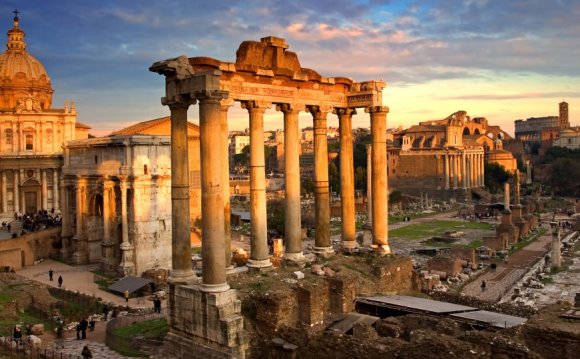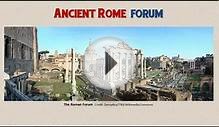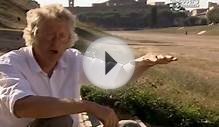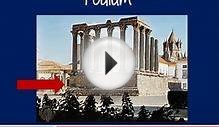
| Lecture 1 | ||
| Roman Architecture (HSAR 252). Professor Kleiner traces the evolution of Roman architecture from its beginnings in the eight-century B.C. Iron Age through the late Republican period. The lecture features traditional Roman temple architecture as a synthesis of Etruscan and Greek temple types, early defensive wall building in Rome and environs, and a range of technologies and building practices that made this architecture possible. City planning in such early Roman colonies as Cosa and Ostia is also discussed, as are examples of the first uses of the arch and of concrete construction, two elements that came to dominate Roman architectural practice. The lecture ends with an analysis of typical late Republican temples at Rome, Cori, and Tivoli. | ||
| Lecture 2 | ||
| Roman Architecture (HSAR 252). Professor Kleiner discusses the revolution in Roman architecture resulting from the widespread adoption of concrete in the late second and first centuries B.C. She contrasts what she calls innovative Roman architecture with the more traditional buildings already surveyed and documents a shift from the use of concrete for practical purposes to an exploration of its expressive possibilities. The lecture concludes with a discussion of the Sanctuary of Fortuna Primigenia at Palestrina, an impressive terraced complex that uses concrete to transform a mountain into a work of architecture, with ramps and stairs leading from one level to the next and porticoes revealing panoramic views of nature and of man-made architectural forms. This course was recorded in Spring 2009. | ||
| Lecture 3 | ||
| Roman Architecture (HSAR 252). Professor Kleiner explores the civic, commercial, and religious buildings of Pompeii, an overview made possible only because of an historical happenstance-the eruption of Mount Vesuvius in A.D. 79, which buried the city at the height of its development. While the lecture features the resort town's public architecture-its forum, basilica, temples, amphitheater, theater, and bath complexes-Professor Kleiner also describes such fixtures of daily life as a bakery and a fast food restaurant. The lecture culminates with a brief overview of tomb architecture in Pompeii and a moving account of what happened to the inhabitants of the city of Pompeii when disaster struck. This course was recorded in Spring 2009. | ||
| Lecture 4 | ||
| Roman Architecture (HSAR 252).
Professor Kleiner discusses domestic architecture at Pompeii from its beginnings in the fourth and third centuries B.C. to the eruption of Vesuvius in A.D. 79. She describes the plan of the ideal domus italica and features two residences that conform to that layout. She then presents the so-called Hellenized domus that incorporates elements of Greek domestic architecture, especially the peristyle court with columns. The primary example is the famous House of the Faun with its tetrastyle atrium, double peristyles, and floor mosaic of the battle between Alexander the Great and Darius of Persia at Issus, a Roman copy of an original Greek painting. She concludes by highlighting the suburban Villa of the Mysteries and notes the distinction between plans of Roman houses and those of Roman villas. |
||
| Lecture 5 | ||
| Roman Architecture (HSAR 252). Professor Kleiner discusses domestic architecture at Herculaneum and the First and Second Styles of Roman wall painting. The lecture begins with an introduction to the history of the city of Herculaneum and what befell some of its inhabitants when they tried to escape obliteration by Vesuvius. She features three houses in Herculaneum, two of which-the Houses of the Mosaic Atrium and the Stags-are among the best examples of a residential style popular in Campania between A.D. 62 and 79. Professor Kleiner then turns to the First or Masonry Style of Roman wall painting, which seeks to replicate the built architecture of Hellenistic kings and other elite patrons by using stucco and paint to imitate a real wall faced with marble. She follows with Second Style Roman wall painting, which uses only paint to open up the wall illusionistically onto vistas and prospects of sacred shrines, city scenes, and landscapes. The lecture concludes with a discussion of the Garden Room from the Villa of Livia at Primaporta, which epitomizes the Second Style by transforming the flat wall into a panoramic window. This course was recorded in Spring 2009. | ||
| Lecture 6 | ||
| Roman Architecture (HSAR 252). Professor Kleiner discusses the development of Third Style Roman wall painting in late first century B.C. villas belonging to the imperial family and other elite patrons. Third Style painting, as Professor Kleiner demonstrates, is characterized by departure from the perspectival vistas and panoramas of the Second Style toward an attenuation of architectural elements and a respect for the inherent flatness of the wall. The Third Style remains popular until the middle of the first century A.D., when it is replaced by the Fourth Style of Roman painting; both styles coexist in the Domus Aurea, the luxurious pleasure palace of the emperor Nero in downtown Rome. Professor Kleiner characterizes the Fourth Style of Roman wall painting as a compendium of previous styles, with imitation marble veneer, framed mythological panels, and the introduction of fragments of architecture situated in an illogical space. | ||
| Lecture 7 | ||
| Roman Architecture (HSAR 252). Professor Kleiner discusses special subjects in Roman wall painting that do not fall within the four architectural styles but were nonetheless inserted into their wall schemes: mythological painting, landscape, genre, still life, history painting, and painted portraiture. The lecture begins with an in-depth examination of the unique Dionysiac Mysteries painting in Pompeii in which young brides prepare for and enter into a mystical marriage with the god Dionysus and simultaneous initiation into his cult. Professor Kleiner then presents a painted frieze from Rome that depicts the wanderings of Odysseus against a continuous landscape framed by Second Style columns. She subsequently analyzes Roman still life, remarkable in its similarity to modern still life painting; a scene of daily life in Pompeii; and a painting depicting a specific historical event-a riot in the Pompeii Amphitheater that caused the arena to be shut down for ten years. The lecture ends with a discussion of painted portraiture on Pompeian walls, including likenesses of two different women holding a similar stylus and wax tablet. This course was recorded in Spring 2009. | ||
| Lecture 8 | ||
Source: www.udemy.com
RELATED VIDEO

Ancient Rome History - Part 2 Roman Architecture - 10

Ancient Rome History - Part 1 Roman Architecture - 09

Love World History: Rome: Roman Architecture









